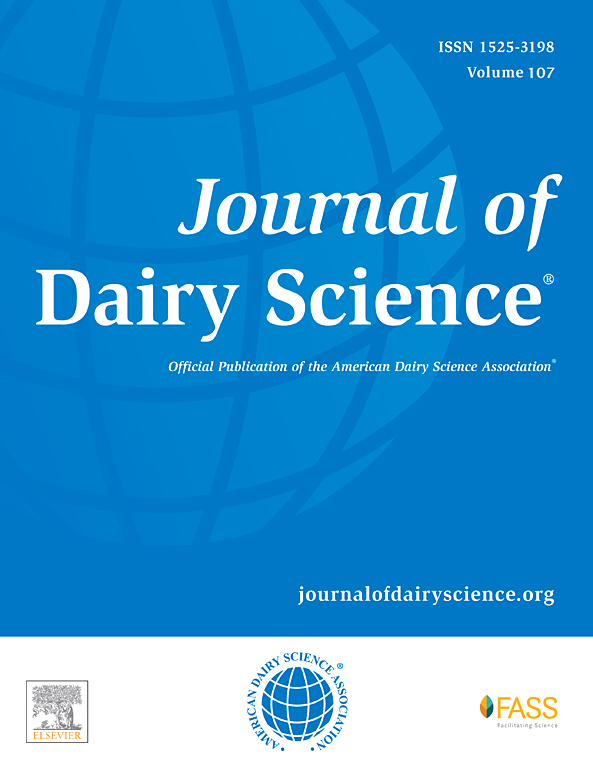Effects of dose, dietary nutrient composition, and supplementation period on the efficacy of methane mitigation strategies in dairy cows: A meta-analysis
IF 3.7
1区 农林科学
Q1 AGRICULTURE, DAIRY & ANIMAL SCIENCE
引用次数: 0
Abstract
The objective of this meta-analysis was to quantify the potential of CH4-mitigating strategies in dairy cattle when accounting for the effects of treatment dose, dietary nutrient composition, and supplementation period. Data from 218 studies with dairy cattle published between 1963 to 2022 were reviewed. Individual CH4 mitigation strategies selected for the analysis were algae (Asparagopsis spp.), 3-nitrooxypropanol, nitrate, lipids, plant secondary compounds, and direct-fed microbials (DFM). Response variables evaluated were daily CH4 emission (g/d), CH4 yield (g CH4/kg DMI), and CH4 intensity (g CH4/kg milk yield [MY] and ECM). Relative mean difference between treatment and control means reported in the studies were calculated and used in the statistical analysis. Robust variance estimation method was used to analyze the effects of CH4 mitigation strategies. Dose, forage-to-concentrate ratio (F:C), dietary concentrations of CP, ether extract (EE), NDF, ADF, and starch, and supplementation period were used as continuous explanatory variables. Data for algae supplementation were limited and responses to studied species were contrasting but, overall, Asparagopsis spp. effectively decreased daily CH4 emission, CH4 yield, and CH4 intensities by 29.8 ± 4.6%, 23.0 ± 5.3%, 34.0 ± 4.3%, and 22.6 ± 7.3%, respectively. Supplementation of 3-nitrooxypropanol decreased daily CH4 emission, yield, and intensity (per kg MY and ECM) by 28.2 ± 3.6%, 28.7 ± 2.8%, 29.2 ± 3.1%, and 31.8 ± 2.8%, respectively, compared with control. Decreasing dietary fiber (i.e., F:C, NDF, and ADF), whereas increasing dietary starch concentration increased the efficacy of 3-nitrooxypropanol at mitigating enteric CH4 emission. Nitrate supplementation decreased CH4 emission, yield, and intensity (per kg ECM) by 18.5% ± 1.9%, 17.6 ± 1.6%, and 13.0 ± 0.2%, respectively, compared with control. Efficacy of nitrate at mitigating enteric CH4 yield and CH4 intensity was positively associated with dose, and efficacy of nitrate at mitigating CH4 yield was positively associated with dietary starch concentration. Lipid supplementation decreased CH4 emission, yield, and intensities by up to 14.8 ± 2.3%, respectively, compared with control. Efficacy of lipids supplementation was positively associated with dietary EE, starch, and supplementation period, but negatively associated with dietary ADF concentration. Free oil supplementation tended to increase lipid efficacy by 31% at decreasing CH4 emission, compared with control. Condensed tannins and plant-derived bioactive compounds decreased CH4 yield by 11.3 ± 2.9% and 5.7 ± 2.5%, respectively, but oregano did not affect enteric CH4 emission metrics in the current meta-analysis. Direct-fed microbials were not effective in mitigating enteric CH4 emission variables. Data were limited to determine the effects of dietary nutrients and duration of supplementation on efficacy of Asparagopsis spp., plant secondary compounds and DFM. Overall, supplementation of the diet with Asparagopsis spp., 3-nitrooxypropanol, nitrate, and lipids were the most effective strategies for decreasing enteric CH4 emission in dairy cattle. Variability in the efficacy of most CH4 mitigation strategies can be partially explained by differences in treatment dose, dietary nutrient composition, and supplementation period.
剂量、日粮营养成分和补充期对奶牛甲烷缓解策略效果的影响:荟萃分析。
这项荟萃分析的目的是,在考虑到治疗剂量、日粮营养成分和补充期的影响时,量化奶牛中减少甲烷排放量策略的潜力。分析回顾了 1963 年至 2022 年间发表的 218 项奶牛研究数据。分析所选的单项甲烷减排策略包括藻类(天门冬酰胺属)、3-硝基氧基丙醇、硝酸盐、脂类、植物次生化合物和直接饲喂微生物(DFM)。评估的响应变量包括每日 CH4 排放量(克/天)、CH4 产量(克 CH4/千克 DMI)和 CH4 强度(克 CH4/千克产奶量 [MY] 和 ECM)。研究中报告的处理平均值与对照平均值之间的相对平均差被计算并用于统计分析。采用稳健方差估计法分析 CH4 减排策略的效果。剂量、饲草与精料之比(F:C)、日粮中的CP、乙醚提取物(EE)、NDF、ADF和淀粉浓度以及补充期被用作连续解释变量。补充藻类的数据有限,对所研究物种的反应也不尽相同,但总体而言,天门冬藻类能有效地减少每天的CH4排放量、CH4产量和CH4强度,降幅分别为29.8±4.6%、23.0±5.3%、34.0±4.3%和22.6±7.3%。与对照组相比,补充 3-硝基氧基丙醇可使每天的 CH4 排放量、产量和强度(每千克 MY 和 ECM)分别减少 28.2 ± 3.6%、28.7 ± 2.8%、29.2 ± 3.1% 和 31.8 ± 2.8%。减少膳食纤维(即 F:C、NDF 和 ADF),而增加膳食淀粉浓度可提高 3-硝基氧丙醇减少肠道 CH4 排放的效果。与对照组相比,补充硝酸盐可使 CH4 排放量、产量和强度(每千克 ECM)分别降低 18.5% ± 1.9%、17.6 ± 1.6% 和 13.0 ± 0.2%。硝酸盐减轻肠道 CH4 产量和 CH4 强度的效果与剂量呈正相关,而硝酸盐减轻 CH4 产量的效果与膳食淀粉浓度呈正相关。与对照组相比,补充脂质可使CH4排放量、产率和强度分别降低14.8 ± 2.3%。补充脂质的效果与日粮 EE、淀粉和补充期呈正相关,但与日粮 ADF 浓度呈负相关。与对照组相比,补充游离油往往能将脂质的功效提高31%,从而减少CH4的排放。缩合单宁和植物源生物活性化合物可分别减少 11.3 ± 2.9% 和 5.7 ± 2.5% 的 CH4 产量,但在当前的荟萃分析中,牛至并不影响肠道 CH4 排放指标。直接饲喂微生物不能有效缓解肠道 CH4 排放变量。在确定膳食营养素和补充时间对拟南芥属植物、植物次生化合物和 DFM 的功效的影响方面,数据有限。总体而言,在日粮中添加拟南芥属植物、3-硝基氧基丙醇、硝酸盐和脂质是减少奶牛肠道甲烷排放的最有效策略。大多数甲烷减排策略效果的差异可部分归因于处理剂量、日粮营养成分和补充时间的不同。
本文章由计算机程序翻译,如有差异,请以英文原文为准。
求助全文
约1分钟内获得全文
求助全文
来源期刊

Journal of Dairy Science
农林科学-奶制品与动物科学
CiteScore
7.90
自引率
17.10%
发文量
784
审稿时长
4.2 months
期刊介绍:
The official journal of the American Dairy Science Association®, Journal of Dairy Science® (JDS) is the leading peer-reviewed general dairy research journal in the world. JDS readers represent education, industry, and government agencies in more than 70 countries with interests in biochemistry, breeding, economics, engineering, environment, food science, genetics, microbiology, nutrition, pathology, physiology, processing, public health, quality assurance, and sanitation.
 求助内容:
求助内容: 应助结果提醒方式:
应助结果提醒方式:


